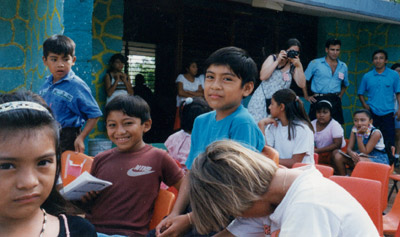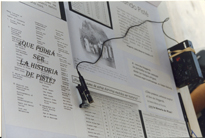|
Faculty
Quetzil Castañeda (continued
from previous page)
Research Areas and Teaching Interests
Geographic Areas, Peoples and Cultures:
• Latin America, México, Guatemala, Mesoamerica
• Indigenous Peoples, US Latina/os, Maya Cultures
Sub-Fields and Topical Specialties:
• Visual Ethnography, Ethnographic Film, Anthropology of Art
• Tourism, Heritage, Museums, Ethnographies of Archaeology
• Indigenous Identity Politics, National Imaginaries, Racial Formations
• Ethnography, Fieldwork Methods, Multi-Media Documentation and Research
• Governance, International Organizations, Non-Governmental Organizations
• History of Anthropology, Ethics, Theory
Castañeda's research on the interconnections of tourism, local Maya communities, the state and anthropology at Chichén Itzá has been identified as opening up a new understanding of the contemporary social effects and consequences of archaeology for local societies and indigenous communities. His research has contributed to the study of archaeology as a present-day social force that has always teamed up with tourism by developing heritage sites and destinations for tourists to appreciate both the cultures and civilizations that are visited and the value of archaeology as a science of the past.
His current research continues this exploration of the ethnography of archaeology or what is also called archaeological ethnography. In the context of OSEA's new Heritage Ethnography Field School (to be inaugurated May 2009), Castañeda is initiating a long-term, multi-team, collaborative investigation of the social contexts of archaeology in the Yucatán.
In addition, Castañeda has worked on projects in the history of anthropology, anthropological ethics, and methods of ethnography. His research on the history of anthropology focuses on the Carnegie Institution of Washington -- CIW -- as a major non-government, non-university and non-museum mode of anthropological science and knowledge production. He is also continuing his research on the role of the CIW in the historical processes leading to the formation of the science-military-industrial complex from WWI through to the end of WWII.
Castañeda's research in the area of ethics takes two interconnected paths. One area of questioning is the place of ethics in ethnography and especially the elaboration of an ethical positioning appropriate for transcultural and experimental fieldwork. The second area of questioning is the changing substance of ethics in archaeology, from a science to a social axiologies or value-systems that define the underlying notions of good and bad in archaeological practice. He is particularly concerned with the conflicts in assessing and judging that can occur in situations where universalist morals are at odds with relativist ethics.
In the area of ethnographic methods, Castañeda has worked with students in the field school context to develop a theory and practice of fieldwork refered to as experimental ethnography and transcultural fieldwork. (See History section of OSEA website). Along the way of working with students to develop these methodological strategies, ethics, and fieldwork ontology, the field school has pioneered an alternative vision of community action or participatory action research. This is manifested in the projects that explore community history and memory, the marketing and aesthetics of Maya art, and the teaching of English to Maya children.
Ethnography Field Schools and Anthropology Training Programs (Study Abroad)
2003–present Founding Director, OSEA — The Open School of Ethnography and Anthropology. Mérida, México. Designed, directed, taught and administered ethnography field schools, study abroad programs, writing workshops, research conferences, book publishing, and research consulting services. www.osea-cite.org
1997-1999 Director, Field School in Experimental Ethnography. Funding from US-México Fund for Cultural Studies. Designed and taught fieldwork and action research methods to undergrad and grad students in three areas of community service: local history, Maya art, and TESL .
1994-1996 Director, Summer Ethnographic Field School Program. Designed collaborations with the Centro Cultural of Pisté including teaching English to community and workshops on Maya calendar. Taught action research methods to undergraduate and graduate students.
Ethnographic & Art Exhibitions Designed as Applied/Action Research
1999 Project Director and Curator, Ah Dzib P'izté’ Modern Maya Art In Ancient Tradition. Durand Art Institute, Lake Forest College, November 29-December 11. Designed and directed a program of activities centered on an ethnographic installation and exhibition of Maya art. Coordinated activities of student participants and visiting Maya Artists from Chichén Itzá, México; organized and lead a Forum on Maya Art with scholars from Field Museum and University of Illinois Chicago; coordinated Workshops led by Maya artists given to students, faculty, and community area high schools. Secured major funding from the US-México Fund.
1999 Project Director and Curator, Primer Concurso de Arte Maya Pisteño. Public Square, Pisté, México, August 11-15. Designed and installed an art exhibition competition; responsibilities included the supervision and management of student researchers and collaborators; organized the participation of community businesses to donate prize money; budget management.
1998 Project Director and Curator, Expo ’98—Arte Maya de Pisté. Municipal Theater of Pisté, Yucatán, México. August 9-11. Designed and installed an art exhibition, I supervised and managed student researchers and organized community collaborators; budget management.
1998 Project Director and Curator, Exposición de Fotografías Históricas de Chichén, 1900-1930. Chilam Balam Ah P’izté Project in Memory and History. Pisté and Chichén Itzá. July 26-28. Designed and installed an exhibition of ethnographic and historical materials; I supervised and managed student researchers, budget, and organized community collaborators.
1998 Project Director and Curator, Ah Dzib P'izté' Market ’98: An Ethnographic Installation And Performance. University of Houston Campus. March 4. Staged and conducted an Maya art exhibition-fair as a class project that used ethnography to explore student views on art and culture.
1997 Project Director and Curator, Expo ’97—Exposición De Arte Maya De Pisté. First Annual Ah Dzib P'izté' Art Exhibition. Municipal Theater of Pisté, Yucatán, México. August 11-13. Installation of artwork of 13 Maya artists and ethnographic materials primarily for local community; based on student collaborative research with artists based on an applied/action research framework.
» Research
» Teaching
» Publications
» Grants and Awards
|




